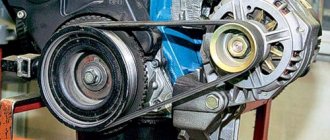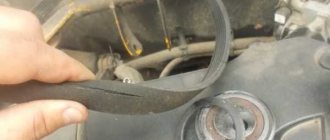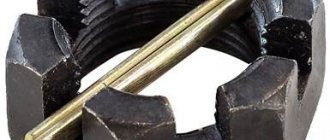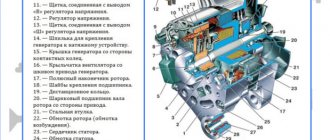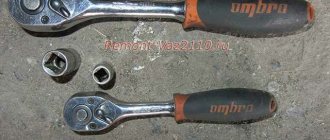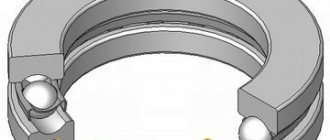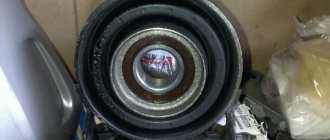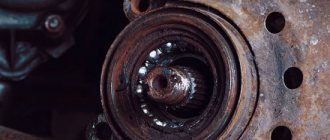Priora. Generator repair.
99% that this is due to the bearings.
We remove the generator from the car. To do this, simply unscrew the lower ear bolt and the upper ear adjusting bolt. We take it to the workbench.
The initial inspection did not show any severely damaged bearings, but a small amount of play was still present. In advance, the owner of the Priora purchased a set of two generator bearings.
Remove the pulley and rear plastic casing. To remove the pulley, we use the original generator belt for the noose. This makes it easier to unscrew and tighten the pulley mounting nut.
We visually inspect (for now) all the elements for burnout, fraying and soot. I didn't like the wiring from the capacitor. The insulation on it had melted. Or frayed. During assembly, I insulated it with electrical tape.
The brush assembly with voltage regulator is new. There are no questions for him. But the copper current collectors are not so hot. The continuity test, voltage regulator and diode bridge did not reveal any anomalies. Everything is in working order.
Now it's up to the bearings. By the way, the plastic support sleeve of the rear rotor bearing, which is located in the rear cover, must also be replaced.
We completely disassemble the generator. We take out the winding and half the covers.
It is better to remove the bearings themselves from the rotor using normal pullers.
True, I had an incident that caused me a lot of trouble. Not because of my crooked hands, but because of my crooked eyes. The domestic manufacturer made the rotor shaft from such raw metal that during the process of pressing out the front bearing, I did not see that under the action of the puller rod, the rotor shaft simply flared out... like plasticine.
And there is a threaded part on which the pulley is seated and the nut is tightened. Thread M14, thread pitch 1. I cursed at myself for a long time...
Anyway. The second problem is that from a set of new bearings, the rear one fit, but the front one turned out to be larger than the old one.
I called the owner and by the evening I had the required bearing. I went to a specialized store and luckily they had the die I needed in stock.
We press on new bearings.
All that remains is to repair the flared threaded shaft. Grinded around the circumference. And cut a new thread.
After which the pulley stood up as it was. Tightened the nut.
All that remains is to put the generator in place. Check the voltage on the battery, start it and check the voltage on the battery with the generator running. In our case, there is charging, everything works quietly and smoothly.
And now, in terms of a lyrical digression. Since the owner of the Priora is a friend of a friend of mine, we started talking. He says that the maintenance of this generator cost him the same as a new one. Considering that I charged him 1000 rubles for such work, I’m surprised. A new one costs around five?! It turns out that he had already changed the “tablet” at some service for 1,800 rubles. 300 rubles per tablet and one and a half thousand for the work! He says they removed the generator from the car while he was there, and that’s why the cost of the work is so high.
Dear Prior owners, the tablet on your generator can be changed without removing the generator from the car! This task takes me 15 minutes, and you have 300 rubles of money)))
So, send away such servicemen who stupidly cheat you out of your money! All the best
Imported or domestic
Imported analogues of bearings have a slightly different designation, namely:
Most 80-amp generators have bearings of similar sizes, at least this applies to domestic ones. If the generator has already been replaced before you, then you may be faced with the fact that a generator from a different manufacturer is installed and the bearings are of different sizes. Depending on the generator manufacturer, bearings of other sizes are sometimes found, for example, in the fairly common Bosch 14V 53-98A 0124 415 038 generator, bearings 6003-2RS (rear) are installed, the dimensions of which are 17 × 35 × 10 and 6303-2RS (front) , respectively, 15×35×14. The same bearings can be found in other imported generators. However, there are options where the rear bearing is designated as 6000-2RS, and the front bearing – 6203-2RS.
In order to accurately determine the dimensions of the bearing, it will have to be removed. If the markings on the bearing are not visible, then it is best to turn to professionals (you should not trust a caliper).
If you have decided on the size of the bearing, then to the repeated question “What bearings are on the VAZ-2110?” The answer suggests itself - original!
The quality of bearings varies from manufacturer to manufacturer; some prefer to install bearings from domestic manufacturers on their generators, while others prefer imported ones. When repairing a generator, everyone decides this issue for themselves, but after listening to numerous tips, some car enthusiasts are inclined to choose imported ones. If you focus on price-quality ratio, many experts recommend DAS LAGER Germany. But there are other suppliers of quality bearings: the French company SNR; FAG is one of the leading companies in Germany; NSK is another major bearing manufacturer from Japan; NTN – Japan; Kouo - part of the Toyota concern of Japan; Kraft or BOSCH.
We also supply bearings from Chinese manufacturers, but the attitude of motorists towards generators and bearings from the Middle Kingdom is far from flattering. A bearing is considered original if it is approved by the vehicle manufacturer for sale on the market. It usually corresponds to what is (or was previously) supplied to the assembly line. The car manufacturer guarantees that these bearings will not let you down.
If you are considering various options, then all the bearings with the corresponding markings at first glance look the same, but after opening the package, you need to pay attention to the marking, which, in addition to the designation of the bearing itself, consisting of digital and letter designations, must contain an indication of the manufacturer and necessarily the country of origin. If this is not the case, then it is quite possible that it is a fake.
In this case, the money lost will not be that big (most often up to 100 rubles per bearing). But you will lose significant time and nerves.
Assembly and disassembly of the generator Lada Priora (Lada Priora), VAZ 2170, VAZ 2171, VAZ 2172
You will need: flat and Phillips blade screwdrivers, 8" and 10" wrenches, 8" and "24" socket wrenches, hammer, tester.
1. Remove the generator from the Lada Priora car (see “Removing and installing the generator”).
2. Remove the voltage regulator (see “Checking and replacing the voltage regulator with brush holder”).
3. Unscrew the three nuts securing the rectifier unit and the two nuts securing the remote bushings of the “plus” terminal and the generator excitation terminal.
4. . then remove the bushings.
5. Unsolder the six leads of the stator winding.
6. . and remove the rectifier unit from the Lada Priora generator.
This is what the removed rectifier unit looks like from the side of the protective casing.
. and so on the stator side.
This is what a capacitor looks like, which is non-removable.
7. Check the “negative” diodes by connecting the “positive” (red) probe of the tester to the “negative” plate (bus) of the rectifier unit, and the “negative” (black) probe alternately to the three contact terminals of the diodes in three mounting places (one at a time) stator windings of the VAZ 2172. If the diodes are in good condition, the tester will show 580–620 Ohms.
8. Connect the “negative” (black) probe of the tester to the “minus” plate of the rectifier unit, and the “positive” (red) probe alternately to the same three contact terminals. If the diodes are working properly, the tester will show an infinitely high resistance.
9. If the tester shows low or close to zero resistance, then the diode is “broken,” if the tester reading tends to infinitely high resistance, regardless of the color of the connected probes, then the diode is “broken.” In both cases, the rectifier unit must be replaced.
10. Check the “positive” diodes in the same way, but only relative to the “positive” plate of the rectifier unit or the “B+” terminal of the generator.
11. Check the stator windings with a tester for the absence of a break (diagram with solid lines) and for the absence of a short circuit to the VAZ 2170 Priora starter housing (diagram with dotted lines). When taking measurements, make sure that the winding leads do not touch the generator cover.
12. Mark the relative positions of the Lada Priora generator covers.
13. . remove the four pinch bolts.
14. . and, using a screwdriver, remove the cover of the VAZ 2171 generator from the side of the slip rings.
15. Remove the stator from the cover.
16. Inspect the stator. There should be no traces of the armature touching the stator on its inner surface. If there is wear, the bearings or alternator covers must be replaced.
17. Place the spanner on the nut and through its hole, insert the hex key into the shaft hole. Unscrew the nut with a spanner wrench, holding the shaft from turning.
18. Remove the spring washer and pulley from the rotor shaft.
19. Remove the rotor shaft from the bearing. If necessary, screw the pulley fastening nut onto the rotor shaft and press the rotor shaft out of the bearing through a wooden spacer with light blows of a hammer.
20. Inspect the cover on the drive side (assembled with the Lada Priora generator bearing).
21. If, when rotating the bearing, you feel play between the rings, rolling or jamming of the rolling elements, the protective rings are damaged or there are lubricant leaks, replace the bearing, and if cracks are found in the cover, especially in the places where the generator is attached, it is necessary to replace the cover of the Lada Priora generator.
22. To replace the bearing or cover, remove the four screws securing the bearing thrust washer.
23. . and remove the washer.
24. Using an aluminum spacer, press the bearing out of the VAZ 2171 generator cover with light blows of a hammer.
25. Press the new bearing into the cap using a socket of the appropriate diameter.
26. Inspect the slip rings. If they have burrs, marks, scratches, signs of wear from brushes and other defects, the rings must be sanded. If damage to the rings cannot be removed with sandpaper, turn the rings on a lathe, removing a minimum layer of metal, and then sand them.
27. Check the resistance of the rotor winding with a tester by connecting it to the slip rings. If the tester shows infinity, it means there is a break in the rotor winding and needs to be replaced.
Replacing Priora generator brushes
- 861 17 758k
- 271 1 275k
Current to power conversion calculator
Convert how many amperes a kW has online. Calculator for converting current amperes to power watts
The generator cannot be called the weak point of the Lada Priora. In fact, at intervals of about 150,000 kilometers, only the brushes need to be changed. The nuance is that it is impossible to replace the brushes themselves in the Priora. And depending on the vehicle’s configuration, this procedure can be either quite simple or very complex. Or it will require removing the generator altogether.
Therefore, in the article we will look at what brushes are used on the Priora, and how they are changed in cars with and without air conditioning, as well as without removing the generator or dismantling it.
Size and catalog numbers
These parameters of the ball bearing are necessary for purchase, since without these numbers it is very difficult to buy the right part suitable for your car.
The dimensions of the bearings varied depending on the year of manufacture of the car, so the selection of a bearing can be carried out based on the year of manufacture. auto.
Cars manufactured before 2001 with carburetor engines they have bearings of type 6302 front and 6202 rear.
Cars produced after 2001 with injection engines, have bearings type 6303 front and 6203 rear.
Catalog numbers (articles) and external dimensions
When do you need to replace generator brushes on a Priora?
Worn generator brushes Priora
This is actually quite easy to determine. Any Priora owner can determine by symptoms when to change the brushes, because he will notice that his car has:
- the headlights begin to burn worse
or the light intensity changes when the engine speed changes; - the network voltage has dropped
(normal level 13.6-14.5V); - The battery charge disappears and the battery light on the instrument panel starts to light up frequently;
- Electrical equipment
turns off or reboots spontaneously.
The charging voltage measurement function on the instrument panel helps in diagnostics. If any of the factors described above manifest themselves, then replacing the generator brushes with a Lada Priora becomes a necessity. Additionally, you can check the condition of the generator brushes and its other components using these instructions.
The most common breakdowns
There are several popular problems with the generator, most of which can be solved by simply replacing components. For example, a vehicle may have a faulty ignition switch, which will require immediate replacement. A break may also occur in the power supply circuit of the instrument devices. You will notice that when you turn the ignition on, the light will stop turning on.
When the generator light does not give any signals both when the engine is running and when the ignition is turned on, check the functionality of the instrument panel. Most likely, the battery is discharged, and the voltage regulator relay is out of order.
Also, the cause of this malfunction is oxidation of the contacts of the commutator rings and brushes, or their excessive wear or breakdown of the diode bridge. In this case, it is recommended to install new elements to replace those that have become unusable.
Even if the control light comes on, but the battery is being recharged, it is recommended to replace the voltage regulator relay. It would be a good idea to check the contact rings of the excitation trim and the contacts between electrical appliances and the generator terminals - they may have broken.
Does the voltage drop sharply, problems arise with the power steering, does the generator not charge or is it overheating? In such cases, it will also need to be replaced.
Priora generator brushes
What voltage regulators can be installed? There is no single original number that would fit the generator - the spare part code depends on the manufacturer. The table shows the most common articles of brushes assembled with a regulator.
| Voltage regulator code | Which generator is it suitable for? | Manufacturer |
| 844.3702 | For 80A generators | Orbit |
| 849.3702 | For 90A generators | Orbit |
| 897.3702 | For 90A and 115A generators | Orbit |
| 9444.3702 | For 80A generators | VTN |
| 9454.3702 | For 90A and 115A generators | VTN |
| 611.3702-01 | For 80A generators | Energomash |
How to change the brushes of a Priora generator without removing
Often, replacing generator brushes on a Lada Priora is done with your own hands. First of all, this is due to savings. Many car services charge a significant fee for this procedure. With the average cost of replacing this part on other VAZ models being 400-500 rubles, for Lada Priora they will charge 2500-3000 rubles for such a service. This is explained by the fact that the generator needs to be removed, and sometimes other parts in the engine compartment will have to be unscrewed. So it turns out that replacing generator brushes on a Priora at a service station costs as much as half a new generator , which is not very cost-effective.
The process of replacing brushes without removing the generator
So, if you decide to replace the brushes with the regulator yourself, then the algorithm of actions is as follows:
- Disconnect the battery.
- Remove the power wire from the generator.
- Disconnect the control lamp input.
- Remove the plastic cover of the generator by unlatching the three latches.
- Unscrew the two fastenings of the voltage regulator with brushes.
- We change the node.
- Putting everything back together.
- Optionally, you can check the battery charging voltage and compare it with the values shown by the on-board system.
The basic algorithm described above is ideal when you need to replace the brushes of a Priora generator without air conditioning . Because in such cars there is enough space between the engine and the radiator, where the generator is installed. In this case, it will be convenient for you to stick your hand in and get to the generator while performing all the operations. Below you will find tips on replacing brushes in a car with air conditioning if this algorithm fails.
By the way, when dismantling the regulator, you can finally be convinced of the need to replace it. Firstly, this is indicated by uneven wear or sticking of the brushes. And secondly, if their length is less than or close to 5 millimeters, then they definitely need to be changed.
Replacing the brushes of a Priora generator with air conditioning without removal (also in the Lux configuration and engines with 16 valves)
Video on replacing Priora generator brushes
The replacement process is no different for vehicles with air conditioning. But on such cars there is little free space left in the engine compartment - as a result, some car owners are unable to stick their hand between the engine and the radiator. This problem is also relevant for owners of 16-valve engines. In this case, try disconnecting the air filter housing, moving it to the side or removing it, and thus provide yourself with room to maneuver.
How to replace alternator brushes on a Priora without air conditioning by removing the alternator
It is best to change the voltage regulator on a removed generator - this makes it more convenient to perform all operations. But to remove the generator on a car without air conditioning, you will need a pit or overpass. This option is used in car service centers and in cases where it was not possible to get there any other way. To dismantle a Priora generator without air conditioning, you need to follow the following algorithm.
The process of replacing brushes with removing the generator
- Disconnect the battery.
- Remove the engine protection.
- Loosen the generator belt tension roller and remove the belt from the pulley (it is not necessary to completely remove the belt).
- Disconnect the wiring block from the D+ connector.
- Disconnect the wires from the contact pin.
- Move aside the rubber boot to unscrew the nut.
- Unscrew the lower clamp nut and remove the clamp screw.
- Unscrew the nut securing it to the upper bracket.
- We take the generator down and then to the right.
- We turn out the adjusting screw and remove the tension bar.
- After making sure that there are no wires left connected to the generator, remove it from the car.
- We replace the voltage regulator and brushes according to the algorithm described above in the section on replacement without removal.
- Installing the generator is done in reverse order. After this, it is very important to adjust the tension of the drive belt.
Air conditioning systems
One of the consumers is a heating device. It is part of the climate control system. A control controller works with this system. The work is automatic. The driver only sets certain parameters.
On cars, the electrical circuit of a VAZ Priora may contain air conditioning systems. After pressing the button, the relay is activated, the compressor is turned on, power is supplied to the electromagnetic clutch, and the pump is turned on. The air conditioning turbocharger begins to rotate, creating pressure, and begins to regulate refrigerant through the system.
Replacing brushes with removing the generator on a Priora with air conditioning
Removing the generator through the headlight
In the case of a Priora equipped with air conditioning, one nuance arises - the compressor of this very air conditioner interferes with dismantling the generator. This complicates the process and makes it more energy-intensive and expensive (if done at a service station). This also explains why many choose the procedure without removal - because removing the generator on cars with air conditioning is quite difficult. Otherwise, the replacement algorithm is no different.
An alternative replacement option without removing the air conditioning compressor is to dismantle the generator and remove the headlight. To do this, you need to remove the protection over the optics, loosen the bumper fastenings, dismantle the headlight and thus gain access to the Priora generator to remove it.
Selection of components
The original generator, installed on a car with a 16-valve engine at the factory, is marked with article number 5102.377. Its cost, as a rule, fluctuates around six to seven thousand.
Carefully check the generator itself and its packaging before purchasing so as not to encounter a counterfeit
It is important that the part is free from unevenness, chips and paint drips, as well as foreign markings.
To avoid overpayments, you can purchase a similar original spare part. The following devices are suitable for installation on Lada Priora:
- VAZ (power 120/115a);
- KZATE (115a);
- BATE (90a);
- BOSCH (120a).
The price of analogues can be either higher or lower than that of the original. As a rule, it is in the region of 3500-6000 rubles. We choose a generator device with a large power reserve so that it lasts longer.
Keep in mind that installing less powerful generators is unacceptable, especially if you connect several different devices to the vehicle’s on-board network (when connecting a large number of electronics, it is generally recommended to increase the current). Before purchasing, we carefully check for damage to the case and the integrity of the unit.
How to remove the generator
It is preferable to have a crane beam indoors; in extreme cases, you can use a jack on wheels, special for hanging the engine. You should proceed in the following way.
- Disconnect the battery terminals.
- Hang up the motor.
- Remove the drive belt.
- Loosen the hoses on the power steering or air conditioning.
- Remove the mountings from the generator.
- The generator can now be disconnected and powered up. First to the side, then up.
- When all wiring is disconnected, the generator can be removed.
Replacing the alternator belt on a Priora 16 valve is carried out in the reverse order, just install the new part following the instructions.
Priora. Generator repair.
99% that this is due to the bearings. We remove the generator from the car. To do this, simply unscrew the lower ear bolt and the upper ear adjusting bolt. We take it to the workbench.
The initial inspection did not show any severely damaged bearings, but a small amount of play was still present. In advance, the owner of the Priora purchased a set of two generator bearings.
Remove the pulley and rear plastic casing. To remove the pulley, we use the original generator belt for the noose. This makes it easier to unscrew and tighten the pulley mounting nut.
We visually inspect (for now) all the elements for burnout, fraying and soot. I didn't like the wiring from the capacitor. The insulation on it had melted. Or frayed. During assembly, I insulated it with electrical tape.
The brush assembly with voltage regulator is new. There are no questions for him. But the copper current collectors are not so hot. The continuity test, voltage regulator and diode bridge did not reveal any anomalies. Everything is in working order.
Now it's up to the bearings. By the way, the plastic support sleeve of the rear rotor bearing, which is located in the rear cover, must also be replaced.
We completely disassemble the generator. We take out the winding and half the covers.
It is better to remove the bearings themselves from the rotor using normal pullers.
True, I had an incident that caused me a lot of trouble. Not because of my crooked hands, but because of my crooked eyes. The domestic manufacturer made the rotor shaft from such raw metal that during the process of pressing out the front bearing, I did not see that under the action of the puller rod, the rotor shaft simply flared out... like plasticine.
And there is a threaded part on which the pulley is seated and the nut is tightened. Thread M14, thread pitch 1. I cursed at myself for a long time...
Anyway. The second problem is that from a set of new bearings, the rear one fit, but the front one turned out to be larger than the old one.
I called the owner and by the evening I had the required bearing. I went to a specialized store and luckily they had the die I needed in stock.
We press on new bearings.
All that remains is to repair the flared threaded shaft. Grinded around the circumference. And cut a new thread.
After which the pulley stood up as it was. Tightened the nut.
All that remains is to put the generator in place. Check the voltage on the battery, start it and check the voltage on the battery with the generator running. In our case, there is charging, everything works quietly and smoothly.
And now, in terms of a lyrical digression. Since the owner of the Priora is a friend of a friend of mine, we started talking. He says that the maintenance of this generator cost him the same as a new one. Considering that I charged him 1000 rubles for such work, I’m surprised. A new one costs around five?! It turns out that he had already changed the “tablet” at some service for 1,800 rubles. 300 rubles per tablet and one and a half thousand for the work! He says they removed the generator from the car while he was there, and that’s why the cost of the work is so high.
Dear Prior owners, the tablet on your generator can be changed without removing the generator from the car! This task takes me 15 minutes, and you have 300 rubles of money)))
So, send away such servicemen who stupidly cheat you out of your money! All the best
Recommendations
Comments 24
Everything was resolved - one bearing was burnt, dry and jammed, the second had a little oil but was loose. I changed the bearings to FBJ. I also changed the slip rings, they were worn out. I wanted to install a three-level regulator, but it didn’t work, which means no luck. The original tablet gives 13.4-13.6 with the low beam on, of course with the air conditioning it will also work, but the tablet is also proven and working
tensioner, take off the belt
According to the code, manufacturer BATE 21120-3701010-05 for 90A (Belarus) front bearing 302
Here are good bearings for the gene
There’s also this garbage: I changed the tensioner periodically, the problem did not go away, for 165,000 I’m already on the third pump, the second gene and the second set of timing belts, but the problem never went away, I have a feeling that until something in the internal combustion engine warms up - there is a rustling sound, it is quite possible that this is the rustling of the engine belt or timing belt. Although, of course, if you take their bearings at the service center, and after starting everything is the same, then the job is not done, if you bring your own, they have the right to say that you brought them from China, but there are no excuses here.
Take off the belt and you will understand the reason, most likely the bearing. The pump may also rustle (on your engine, oh no)
and the bearings are in the genes: the rear is always 202, and the front is 302 (old model, 15 shaft) or 303 (new model, 17 shaft)
and in front of this where is the pulley?
Yes, the front is where the pulley is, and the back is where the brushes go.
and in front of this where is the pulley?
there is a method for determining without removing the pulley and measuring, but I’ll make a reservation, it’s mine personally and if I’m absolutely sure that no one has repaired the generator before: if the RR is of the old model, without wiring, then the gene is of the old model and the front bearing is 302. If the RR is of a new model, with two additional wires, the front bearing is 303.
Oh, I'll watch it tomorrow!
there is a method for determining without removing the pulley and measuring, but I’ll make a reservation, it’s mine personally and if I’m absolutely sure that no one has repaired the generator before: if the RR is of the old model, without wiring, then the gene is of the old model and the front bearing is 302. If the RR is of a new model, with two additional wires, the front bearing is 303.
Your method is incorrect. Nothing depends on the type of launch vehicle. And it depends on the manufacturer. The rear covers of the generator are the same, the seat for the launch vehicle and the diode bridge are the same. The same generators may have one relay or another.
Method 100%. Manufacturer: factory. Rubbish like China, Ukraine, etc. In principle, I don’t consider it.
Your method is incorrect. Nothing depends on the type of launch vehicle. And it depends on the manufacturer. The rear covers of the generator are the same, the seat for the launch vehicle and the diode bridge are the same. The same generators may have one relay or another.
On generators n/o there is also a pp n/o and a reinforced front cover, respectively, bearing 303. The method is 100%, if no one has climbed into the gene, I already wrote about this.
In this case, I have only seen the “new model” generators you indicated in one Samara and one Chevy Niva. (But I often install these DM and RN myself. Instead of the usual ones)
And the rest of the cars, including those bought in a store and untouched by generator repairs, I came across with generators of both standard sizes, pulley mounting nuts, rotor shaft diameter, etc. But with a conventional LV and a nine-diode bridge. Somehow your 100% theory doesn’t work.
By the way... I repair on average from two to ten generators per week. Sometimes 3-4 a day... I’m silent about China, that’s understandable. It's complete horror.
I don’t know what kind of generators you have there, where they get them from and who installs them. I have 126 cars in my fleet, all from the factory. I don’t think it’s the leftists (those who come from the street for repairs, the so-called “shabashki”), you can ask AvtoVAZ for these genes, they’ll say the same thing as me. Well, I personally became convinced of this while repairing a car. AvtoVAZ’s letter about genes is 100% confirmed. Another thing is that the genes n/o and s/o are not linked by year - yes (n/o can be on a car produced in 2004, but on a car produced in 2007, for example, it comes from the factory with a c/o, etc. .) P.S: here only about factory genes, not about Bulgaria, China, basement kzate - of which more than half are in the stores in our city. the engraving is somehow crooked) p.s.: we have genes n/o and s/o about 50/50 on the car.
and the bearings are in the genes: the rear is always 202, and the front is 302 (old model, 15 shaft) or 303 (new model, 17 shaft)
If the pulley mounting nut is S24, then bearing 6303. If the nut is smaller, S21, then 6302.
Don’t forget about the tension roller, just stop by the service center and listen with a stethoscope, give them a hundred rubles and you’ll know exactly what to change
the sound comes from the gap between the cover farthest from the pulley - there are technological gaps there
How to remove a generator on a Lada without air conditioning
If you do not have additional equipment installed, replacing the Priora 16 valve generator will be a little easier, since there will be more space under the hood.
- Remove the negative terminal from the battery.
- Remove the protection from the engine.
- Unscrew the nut on the belt tensioner (not completely, a maximum of four turns). Now you can turn it around by turning the screw a little. When it is loose enough, you can remove it.
- Remove the protective cap to later remove the terminal from the wiring harness. Now you can remove the wiring block.
- Remove the nut to remove the top mounting bolt, then do the same with the bottom mounting bolt.
- Remove the belt and then the entire generator.
Since in advanced configurations with air conditioning the belt on the generator is longer, then if it is necessary to replace it, you need to remember some subtleties. Especially if you feel that the quality of grip on the rollers has become much worse, then you will have to re-tension or change them. The first thing that indicates a problem is a whistle, a clear decrease in the battery charge level, even if it should be fully charged. New batteries can be ordered here: https://www.rimir.by/products/car/akkumulyatory-95/. In this case, first of all, you should look at the belt to see if it is elastic, if there are any third-party cracks on it.
Replacing the Priora 16 valve alternator belt should be done after 60 thousand kilometers, or once every two years.
Instructions for removing the unit on a car with air conditioning
Before replacing the generator bearing on a Priora, you should stock up on a set of tools, which will include:
- universal set of keys. Heads for 7, 10, 12, 13, 17, 24 are required;
- set of hexagons;
- universal puller for ball bearings;
- minus and Phillips screwdriver;
- To diagnose serviceability, you will need a multitester;
Removing a generator on a Priora Lux, with air conditioning and power steering
If you need to replace the generator bearing on a car that is not equipped with air conditioning, then it is convenient to remove it by dismantling the right headlight of the Lada Priora. The unit is located on the left side of the engine when viewed from the radiator. The best access to the mechanism is to remove the headlight and bumper mount on the passenger side.
Note: Attention! All work related to the repair of “genes” is done with the negative terminal of the battery removed
- Disconnect the terminal.
- Remove the protective cover.
The headlight is attached to 2 bolts - one under the housing, the second from below the headlight. It can be accessed by removing the bumper mount on the right side.
- Unscrew the top headlight mount.
- Lower the right side of the bumper to gain access to the lower headlight mount.
- We unscrew the lower bolt and the headlight is removed from its mounts. Carefully disconnect the power cables and set the headlight aside.
- This is what you will see from the headlight side: access to the fasteners, pulley, and belt tension adjustment.
Reasons for failure
There are many reasons for bearing failure, but there are several main reasons, which are discussed below.
Wear
Wear is a typical cause of bearing failure, since the number of revolutions of the generator rotor is huge over the Nth period of time. Consequently, the lubricant in bearings under the influence of high temperatures loses its properties and the bearing ceases to receive the required slip coefficient, which causes heating and increased clearances in the ball part of the bearing.
Belt tension
Excessive tension on the alternator belt greatly affects the life of its bearings. It is necessary to tension the belt correctly, observing all norms. The generator belt should bend under the influence of 10 kg. by 5-7 mm.
How to tension a belt and check its tension
For Priora, in addition to the original ones, similar belts from foreign brands such as Contitech, Dayco, Gates, and Flennor are recommended.
- Loosen the roller nut; you will have to hold the cage with a wrench. By then rotating this key, the clip can be turned.
- Tighten the nut against the roller. Check the quality of tension only on the long section between the pulleys. If, when pressing on the belt in this place, it bends no more than 10 millimeters, the tension is appropriate.
- If your Lada has a hydraulic booster, you should tighten it a little more. If you don't pull it tight enough, it will whistle obviously, a defect that can be easily detected by ear. Then pull it a little tighter. If you hear not a whistle, but a hum, the belt, on the contrary, needs to be lowered.
On a Priora, in a regular service, changing just the belt can cost from 300 rubles (not counting consumables). If the generator is with rollers or mounted, then the price will increase significantly to one and a half thousand rubles. Do not forget the receipt for the services provided; the warranty for the work performed must be at least six months; if the belt deteriorates due to poor installation or tension, you must demand a replacement at the expense of the service.
The replacement generator itself starts at 5 thousand rubles. The cost of removal and installation work alone will average 1000 rubles for simple models.
Priora generator repair,
Repair of the generator “Priora” by real boys))) Repair of the generator “Priora”
Generator bulkhead VAZ 8,9,10,11,12,13,14,15 Priora, Gazelle Volga, Sable
Generator bearings. How to replace.
Repair of VAZ generator (replacement of slip rings)
Disassembly and assembly of the Lada Priora generator (VAZ-2170)
We disassemble generator 5102.3771 to check and replace the voltage regulator, rectifier unit, rotor, stator and bearings.
Checking the generator is shown in the “Fault Diagnosis” section.
The voltage regulator can be replaced on the car without dismantling the generator. For clarity, we show the replacement of the voltage regulator on a removed generator.
Use the 8mm socket to unscrew the nut...
...and remove the terminal from the “D+” terminal of the generator.
Using the “8” socket, unscrew the three nuts securing the casing.
Remove the generator casing.
Using a slotted screwdriver, unscrew the screw securing the voltage regulator output.
Using the “8” socket, unscrew the two nuts securing the voltage regulator.
Remove the voltage regulator.
We remove the gasket. To disassemble the generator...
...remove three washers from the casing mounting studs.
We use a marker to mark the relative positions of the generator covers.
Using a 7-point socket, unscrew the four bolts holding the covers together.
Remove the back cover with the stator assembly. If the stator does not come out of the front cover, pry it off with a screwdriver from different sides relative to the front cover.
We put a high “24” head on the pulley fastening nut and through its hole insert a “8” hexagon into the hole of the rotor shaft. We unscrew the pulley fastening nut, holding the tool head with a pipe wrench or in a vice.
Remove the spring washer.
...and a spacer washer.
We push the rotor shaft out of the front cover...
...and remove the cover. To replace the front bearing...
... use a slotted screwdriver to unscrew the four screws securing the bearing pressure plate.
Remove the pressure plate.
Use your hands to push the bearing out of its seat...
...and remove it. If it is not possible to push out the bearing, we knock it out using a mandrel or tool head of a suitable diameter.
To replace the rear bearing...
...using a two-jaw puller we press the bearing from the rotor shaft. When performing this operation, the puller screw should be pressed exactly into the center of the shaft so as not to damage the plastic insulator of the rotor slip rings. To install the puller grips, two flats are made on the plastic rotor bushing.
If it is necessary to remove the rectifier unit or stator...
...unsolder the six terminals of the stator winding from the terminals of the rectifier block... ...and unscrewing the three fastening nuts with an “8” wrench, remove the rectifier block and the stator.
We assemble the generator in reverse order.
To install the rear bearing, we rest the front end of the rotor shaft on a wooden block...
...and press the bearing onto the rear end of the shaft using a mandrel or a piece of pipe of suitable diameter, applying force only to the inner ring of the bearing. If the front bearing cannot be inserted into the generator cover...
...press the bearing into the cover using a suitable tool head, applying force to the outer ring of the bearing.
